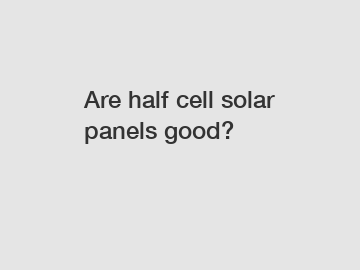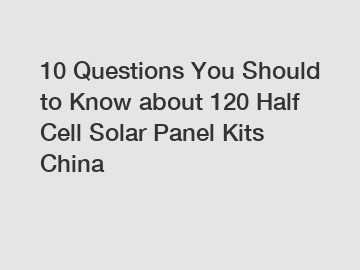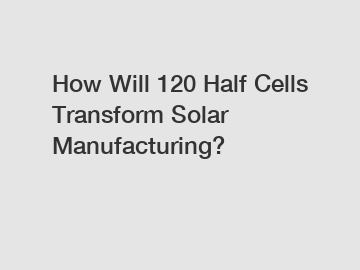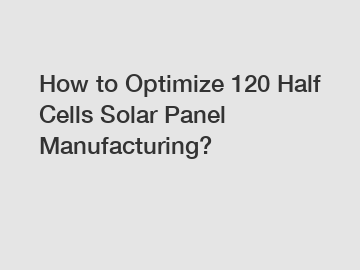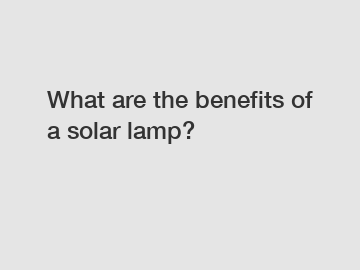Difference between Mono PERC, HJT & TOPCon solar ...
Difference between Mono PERC, HJT & TOPCon solar ...
Solar panel manufacturing technology has come a long way over the years, and there have been significant advancements recently with the introduction of mono PERC, Topcon and HJT technology. These new technologies have led to improvements in solar panel efficiency, durability, and overall performance, thus, making them a more viable and cost-effective option for renewable energy production. Let us discuss each solar PV module technology and understand the differences.
Please visit our website for more information on this topic.
PERC Solar PV Modules
In recent years, Passivated Emitter and Rear Contact (PERC) solar panels have been gaining popularity in the solar panel industry as a viable option for creating more efficient solar power. These solar panels use PERC solar cells, an improved version of conventional solar cells. Their modified design allows them to generate 6 to 12 per cent more energy than their traditional counterparts.
About PERC Technology
PERC stands for Passivated Emitter and Rear Cell. The PERC solar cell has a presence of a passivation layer at the back side of the cell, which helps to minimize recombination losses and increase light absorption. The key role of the rear-side passivation layer is to reflect light that passes through the silicon cell without being absorbed back into the silicon. By reflecting this light, the passivation layer gives the solar cell a second chance at absorbing it, resulting in significant improvement in efficiency.
Advantages of PERC Solar Panels
PERC panels offer several benefits over traditional solar panels, which make them a popular choice for solar installers and customers. Here are the key advantages:
-
Increased Energy Production
: PERC solar panels have higher efficiency compared to traditional panels, resulting in increased power generation. It can add up to a 5% increase in energy production for a full PV system.
-
Increased Low-light and High-heat Performance
: PERC panels perform exceptionally well in low-light and high-heat environments, providing an increased efficiency of around 3%.
-
High Area Efficiency
: Because PERC panels are more efficient, they can achieve the same power output as traditional panels with fewer panels. This means a solar power system using PERC panels will need a lesser amount of space for installation.
-
Reduced BOS Costs
: With PERC panels, fewer panels can achieve the same output, resulting in reduced balance of system (BOS) costs, labour costs, and other soft costs such as inverters and disconnects.
Disadvantages of PERC solar panels
PERC solar panels are generally more expensive than traditional solar panels.
-
PERC solar panels
are slightly more sensitive to shading than traditional solar panels.
PERC solar panels are a relatively new technology, there may be some uncertainty about their long-term durability and performance.
Applications of PERC solar panels
-
Residential rooftops:
Mono PERC solar panels
are a popular choice for residential rooftops due to their high efficiency, which allows homeowners to generate more electricity from a smaller roof space.
-
Commercial buildings:
Mono PERC solar panels can also be used on commercial buildings, such as office buildings, shopping malls, and warehouses, to offset electricity costs and reduce carbon emissions.
-
Large-scale solar power plants:
Mono PERC solar panels can be used in large-scale solar power plants to generate electricity on a utility scale.
Tunnel oxide passivated contact (TOPCon) solar technology is a relatively new type of solar cell technology. TOPCON stands for 'Tunnel Oxide Passivated Contact'.
About TOPCon Technology
The TOPCon solar cell structure consists of a thin tunnel oxide layer sandwiched between a transparent conductive oxide (TCO) layer and a p-doped crystalline silicon layer. The TCO layer acts as a front contact for the solar cell, while the p-doped layer acts as the absorber layer. The tunnel oxide layer acts as a passivation layer, preventing the recombination of charge carriers at the surface of the solar cell. Increased efficiency enables the solar panel to capture a greater amount of energy per unit area.
Advantages of TOPCon Solar Panels
The adoption of TOPCon technology has gained popularity due to several benefits associated with it. Here are some of the key advantages of using TOPCon solar cell technology:
-
Manufacturing process: TOPCon solar cells can be manufactured with the same machines as P-type solar cells, i.e. manufacturers don't need to make any high capital investment to adopt this technology, making it easier and more cost-effective to produce TOPCon solar panels on a large scale.
-
Higher efficiency: TOPCon cells are more efficient in converting sunlight into electricity than P-type cells. The maximum efficiency of TOPCon cells is around 28%, which is higher than the maximum efficiency of about 24% for PERC cells. This higher efficiency results in more electricity generation from a given surface area.
-
Lower degradation: TOPCon modules have a lower power degradation during the first year and over the 25 years of use, compared to PERC solar PV modules. Hence, they will maintain their efficiency for a longer time, resulting in a longer lifespan of the solar panels.
-
Lower temperature coefficient: The temperature coefficient of TOPCon solar panels is lower than that of PERC solar panels. It means that TOPCon solar panels can maintain their efficiency at higher temperatures, which is particularly important in hot climates.
-
Bifaciality rate: TOPCon cells have higher bifaciality than PERC cells. It means that TOPCon solar panels can generate electricity from both the front and the back of the solar panel.
-
Low light performance: TOPCon solar modules have higher efficiency in low-light conditions than PERC modules. It means that TOPCon solar panels can generate more electricity even when there is not enough sunlight.
Disadvantages of TOPCon Solar PV Module Technology
Here are some potential challenges before TOPCon solar cell technology
-
Cost
: TOPCon solar cells can be more expensive to produce than traditional solar cells due to the additional materials and manufacturing steps required to create the thin-film layers needed for the cell.
-
Complexity:
The manufacturing process for TOPCon cells is more complex than for traditional cells, which can make it more difficult to scale up production to meet high demand.
-
High-temperature processing
: The production of TOPCon cells requires high-temperature processing steps, which can lead to increased energy consumption and carbon emissions, as well as the risk of defects or damage to the cell.
-
Sensitivity to impurities:
TOPCon cells are more sensitive to impurities in the materials used to create them, which can lead to reduced efficiency or even complete failure of the cell.
Comparison Between PERC and TOPCon Solar Technology
When compared to a PERC solar cell, a TOPCon solar cell appears visually identical once installed in a module. However, Unlike PERC cells, TOPCon cells are made from n-doped silicon, which is more challenging to manufacture. However, this material allows TOPCon cells to achieve higher degrees of efficiency.
Another significant difference is the more laborious passivation process used for TOPCon cells. Despite being more technically challenging, this process achieves a greater effect. Specifically, applying a layer of polycrystalline silicon to the rear side of the cell requires significant technical effort but allows the solar cell to handle higher voltages, resulting in an increase in overall efficiency.
Applications of TOPCon Solar Panels
-
Utility-scale solar power plants:
TOPCon solar panels are often used in utility-scale solar power plants due to their high efficiency, which allows for more electricity to be generated from a smaller area.
-
Agriculture and farming:
TOPCon solar panels can be used for agricultural applications such as water pumping, irrigation, and crop drying, providing off-grid electricity to remote areas.
-
Electric vehicle charging stations:
TOPCon solar panels can be used to power electric vehicle charging stations, allowing for clean and sustainable transportation.
HJT Solar PV Module
Heterojunction (HJT) solar cell technology is a relatively new type of solar cell that has been gaining popularity in recent years. The design and structure of HJT allow for a more efficient conversion of sunlight into electricity.
About HJT Solar Panel Technology
Heterojunction solar panels are a type of photovoltaic panel that consists of three layers of photovoltaic material. These panels incorporate two distinct technologies: crystalline silicon and amorphous "thin-film" silicon, which work in harmony to produce electricity.
HJT cells consist of three main materials: Crystalline Silicon (c-Si), Amorphous Silicon (a-Si) and Indium Tin Oxide (ITO)
The first layer, made of amorphous silicon, captures sunlight before it reaches the crystalline layer, as well as any light that reflects off the underlying layers. The middle layer is composed of monocrystalline silicon, which is primarily responsible for converting most of the sunlight into electricity. The final layer is another amorphous thin-film silicon layer, located behind the crystalline silicon, which captures any remaining photons that have passed through the first two layers.
By combining these two technologies, heterojunction solar panels can generate more energy than either technology could produce independently. These panels can achieve efficiencies of 25% or higher, making them an attractive choice for solar energy generation.
Advantages of HJT Solar Panels
If you want to learn more, please visit our website GECONA SOLAR.
Additional reading:End-of-Life Management for Solar Photovoltaics
The Benefits of Using EcoSmart Solutions
Key Questions to Ask When Choosing Solar Panels
Unlock Savings: Benefits of 120 Half Cell PV Panels Explained
Maximize Energy: Benefits of 120 Half Cell PV Panels
How to Choose Commercial and Industrial Solar Panels?
How Can Industrial Energy Storage Revolutionize Sustainability?
Here are the major benefits of Heterojunction (HJT) solar panels summarized into short points:
-
High Efficiency:
HJT solar panels have a conversion efficiency of 26.07% for monofacial modules and over 30% for bifacial, making it one of the most efficient solar technologies in the industry.
-
Good Temperature Coefficient:
HJT cells are less affected by changes in temperature, making them great for use in high-temperature locations.
-
High Bifaciality:
HJT cells have a high bi-faciality factor of 92%, making them a great choice for utility-scale applications that can take advantage of the albedo resource.
- Easy Manufacturing Process: The HJT solar PV module manufacturing process only involves 5-7 steps, and the cost of equipment is constantly being reduced, making it a cost-effective and promising technology for the future of solar energy.
Disadvantages of HJT Solar Panels
Heterojunction (HJT) solar panels offer several advantages, but they also have some drawbacks. Here are the main disadvantages of HJT solar panels:
-
High Cost:
HJT panels are more expensive due to the additional steps in manufacturing and costly materials.
-
Fragility:
HJT panels are thin and have a complex structure, making them more vulnerable to damage.
-
Sensitivity to Humidity:
HJT panels are sensitive to moisture, which can reduce their efficiency or damage the panel.
-
Complexity of Production:
The manufacturing process for HJT panels requires specialized knowledge and equipment.
-
Low Manufacturing Scale:
HJT panels are produced at a lower scale than traditional panels, which can make them more expensive and harder to find.
-
New Technology:
HJT panels are a relatively new technology, and experience with installation and maintenance may be limited.
Comparison Between HJT and TOPCon Solar PV Module Technology
TOPCon and HJT solar panels are two advanced solar technologies that offer high efficiency and reliability. Here are some general features where two solar panels can differ:
HJT panels have higher efficiency and bi-faciality, but are more complex and expensive to manufacture, and are sensitive to humidity.
TOPCon panels have a simpler manufacturing process, lower cost, and are less sensitive to humidity, but have lower efficiency and bi-faciality compared to HJT panels.
Applications of HJT Solar Panels
-
Building-integrated photovoltaics (BIPV):
HJT solar panels can be integrated into building facades, roofs, and windows to generate electricity while also providing architectural design and energy-saving benefits.
-
Space-constrained applications:
HJT solar panels are a good choice for space-constrained applications such as portable solar chargers, off-grid cabins, and small boats, due to their high efficiency and compact size.
-
Utility-scale solar power plants:
HJT solar panels can be used in large utility-scale solar power plants, especially for projects with higher solar irradiance, which increases the efficiency of the HJT panels.
Conclusion
In summary, HJT panels offer the highest efficiency and bi-faciality, but are the most complex and expensive to manufacture and are sensitive to humidity. TOPCon solar panels have a simpler manufacturing process and are less sensitive to humidity, but have lower efficiency and bifaciality compared to HJT panels. Mono PERC panels have a simpler manufacturing process than both HJT and TOPCon panels but have lower efficiency and bifaciality compared to HJT panels.
In India, PERC (Passivated Emitter and Rear Cell) technology is widely used and is considered a good choice for most applications. Moreover, Mono PERC solar panels are known for their reliability, durability, and longevity. Topcon panels are relatively expensive and may not be cost-effective for all applications. Both TOPCon & HJT solar panels are also relatively expensive and Both TOPCon & HJT may not be widely available in India.
We can conclude Mono PERC panels are a good choice for most solar applications in India, but the suitability of a particular technology ultimately depends on a variety of factors. It is best to consult with a reputable solar energy company to determine the most appropriate technology for your specific needs and budget.
Bifacial Solar Panels: Everything You Need to Know
The concept of bifacial solar panels might seem cutting-edge, but its roots stretch back further than you might imagine. Born from a flash of inspiration in the s, this innovative idea remained largely dormant for decades. It wasn't until the early s that bifacial technology began to emerge from the shadows of solar innovation. Unlike traditional solar panels, these innovative devices capture sunlight from both sides, significantly increasing energy yield. By harnessing reflected light from surrounding surfaces, bifacial panels can boost energy production by up to 30% compared to their monofacial counterparts. As the world seeks sustainable energy solutions, bifacial solar panels emerge as a promising option, combining increased efficiency with reduced installation costs.
What Is a Bifacial Solar Panel
As the name implies, a bifacial solar panel is a module that has photovoltaic cells on both the front and back sides, designed to capture sunlight from both sides of the panel. Unlike traditional solar panels that only collect light from the front, bifacial panels harness energy from both their front and back surfaces.
These innovative panels typically feature a transparent backing, allowing them to absorb direct sunlight from the front and reflected light from the ground or nearby surfaces on the rear. This dual-sided approach significantly boosts their energy-generating potential.
Key features of bifacial solar panels include:
- Double-sided light absorption
- Increased energy yield (up to 30% more than traditional panels)
- Improved performance in low-light conditions
- Versatility in various installation settings
Bifacial panels are particularly effective in environments with highly reflective surfaces, such as snow, sand, or light-colored roofs. They can be installed vertically, horizontally, or at an angle, making them adaptable to diverse architectural designs and geographical locations.
As the solar industry continues to advance, bifacial panels represent a promising solution for maximizing energy production in both residential and commercial applications. Their ability to generate more power in the same footprint as traditional panels makes them an attractive option for those looking to optimize their solar energy systems.
How Do Bifacial Solar Panels Work
Bifacial solar panels work by harnessing sunlight from both their front and rear surfaces, maximizing energy capture. The front side operates like a traditional solar panel, converting direct sunlight into electricity. The innovation lies in the panel's rear side, which is designed to absorb reflected and diffused light from the surrounding environment. This is made possible by a transparent or translucent back sheet, allowing light to penetrate both sides of the panel. The specialized photovoltaic cells within are optimized to convert light from any direction into usable energy. The effectiveness of the rear side, known as the bifaciality factor, typically ranges from 65% to 90% of the front side's capacity. Mounting considerations play a crucial role, with elevated installations or reflective surfaces underneath enhancing rear-side production. This dual-sided approach allows bifacial panels to generate more electricity in various lighting conditions, making them particularly effective in environments with high albedo or diffused light.
Bifacial Solar Panels Advantages and Disadvantages
Due to their price and efficiency, bicluster solar panels are growing in popularity. Bifacial panels are becoming more popular than monofacial panels, therefore more residences and businesses are installing them to take advantage of the benefits. But do the benefits really exceed the drawbacks?
Pros of Bifacial Solar Panels
- Increased Energy Production: Bifacial panels yield 5-30% more power than traditional panels. This boost comes from their ability to capture light from both sides, significantly increasing energy output.
- Better Low-Light Performance: These panels excel in capturing diffused and reflected light. This feature extends their daily operational hours and improves performance in less sunny conditions.
- Durability: Most bifacial panels feature a double-glass construction, enhancing their resilience. This robust design typically results in longer warranties and an extended operational lifespan.
- Versatility: Bifacial panels are suitable for various installation types, including ground, rooftop, and carports. Their flexibility allows for creative deployment in diverse settings.
- Potential for Lower LCOE: Higher energy yield can lead to better long-term economics. Over time, the increased production often offsets the higher initial investment.
- Reduced PID: The glass-on-glass design of bifacial panels helps minimize potential induced degradation. This results in more stable performance over the panel's lifetime.
Cons of Bifacial Solar Panels
- Higher Initial Cost: Bifacial solar panels generally come with a higher price tag than conventional models. This increased upfront investment can be a deterrent for some buyers, particularly in residential applications.
- Complex Installation Requirements: Maximizing benefits requires careful planning and potentially more sophisticated mounting systems. Installers need to consider factors like optimal tilt angle, elevation, and surrounding reflective surfaces.
Bifacial Vs. Monofacial Solar Panels
Monofacial solar panels, the traditional choice, feature photovoltaic cells on one side only. They capture direct sunlight from the front surface, with an opaque backing. These panels are less expensive and simpler to install, making them popular for residential rooftop applications.
Bifacial solar panels, in contrast, absorb light from both sides. This dual-sided design captures direct sunlight from the front and reflected or diffused light from the rear. While more expensive, bifacial panels can produce up to 30% more energy under optimal conditions.
The choice between the two depends on the installation environment. Bifacial panels excel in areas with reflective surfaces or elevated installations, while monofacial panels suit standard rooftop setups. Bifacial panels offer higher energy yields per square foot, ideal for maximizing output in limited spaces, but at a higher initial cost.
Are Bifacial Solar Panels Worth It
Determining whether bifacial solar panels are worth the investment depends on several factors. These innovative panels offer the potential for increased energy production, but their value proposition varies based on specific installation conditions and project goals.
For large-scale solar farms or commercial installations with ample space and reflective surfaces, bifacial panels often prove their worth. The additional energy yield, which can range from 5% to 30% more than traditional panels, can significantly offset the higher initial costs over time. This increased efficiency is particularly valuable in areas with high electricity rates or limited installation space.
Residential applications present a more nuanced scenario. While the energy boost is appealing, the higher upfront costs and potential installation complexities may extend the payback period. Homeowners should carefully consider their roof orientation, local climate, and surrounding reflective surfaces to assess the potential benefits.
How to Install Bifacial Solar Panels
Installing bifacial solar panels is a smart way to boost your energy efficiency. Here's a concise five-step guide to help you get started:
1. Site Assessment and Planning
Begin by evaluating your site to identify the optimal location for your bifacial solar panels. Choose areas with high reflectivity, such as snow-covered or sandy regions, to maximize the panels' efficiency. Ensure there are no obstructions like trees or buildings that might cast shadows on the panels. Additionally, check local regulations and obtain any necessary permits to comply with legal requirements.
2. Choose and Prepare the Mounting System
Select a mounting system that supports bifacial panels, such as ground mounts, rooftop mounts, or tracking systems. Prepare your installation site by clearing debris and leveling the ground if you're using a ground mount. For rooftop installations, ensure the roof is structurally sound and can support the panels' weight. Assemble and install the mounting system according to the manufacturer's instructions, ensuring it is securely anchored.
3. Install the Bifacial Solar Panels
Carefully mount the bifacial solar panels onto the prepared system. Secure the panels using the provided clamps or brackets, ensuring there's adequate space between the panels and the surface below to allow reflected light to reach the underside. Proper installation is crucial for both stability and efficiency.
4. Connect Electrical Components
Connect the solar panels to the inverter and integrate them into your home's electrical system. Ensure all electrical connections are properly insulated and waterproofed to prevent any hazards. It's highly recommended to hire a certified electrician for this step to ensure safety and compliance with local electrical codes.
5. Optimize and Monitor
Adjust the angle and orientation of the panels to maximize exposure to both direct and reflected sunlight. Tracking systems can be particularly beneficial for this purpose. After installation, test the system to ensure it's functioning correctly and monitor its performance regularly. Clean the panels periodically to remove any dirt or debris and schedule maintenance checks to ensure long-term efficiency and durability.
Tips for Installing a Bifacial Solar System
- Don't Block the Back Sides of the Panels. Bifacial solar panels capture sunlight from both sides, boosting energy generation. Ensure that inverters or racking do not block the back of the panels. If racks are necessary, leave space to allow sunlight to reach the cells.
- Allow Space Between Panel Rows. Leave 3-5 inches between panel rows to let snow fall through in winter, preventing pile-up and aiding in melting, which produces heat for the panels.
- Maintain 42.5 Inches Between the Ground and the Panels. The IEEE recommends a 42.5-inch height from the ground to allow snow to accumulate without shading the panels and to ensure optimal performance.
- Use Reflective, Light-Colored Materials Under the Panels. For maximum power output, avoid dark and non-reflective surfaces under the panels. Use reflective, light-colored materials or white EPDM for rooftop installations.
Conclusion
Bifacial solar panels offer significant advantages in energy generation by capturing sunlight from both sides, making them a smart choice for maximizing efficiency. When installing these panels, ensure that the back side remains unobstructed, allow sufficient spacing between panel rows, and maintain an optimal height from the ground. Additionally, use reflective, light-colored materials underneath the panels to further enhance their performance.
For those seeking high-quality bifacial solar panels, the Renogy Bifacial 220 Watt 12 Volt Monocrystalline Solar Panel is an excellent option. With its advanced bifacial design, this panel can generate up to 285 Watts, significantly outperforming traditional mono-facial panels. Its ten bus bars ensure excellent performance even when partially shaded, and the PERC monocrystalline cells help reduce heat and increase voltage, optimizing overall efficiency.
Choose Renogy for reliable and high-performance bifacial solar panels that meet your energy needs while maximizing power output and efficiency.
Frequently Asked Questions about Bifacial Solar Panels
1. How efficient are bifacial solar panels?
Bifacial solar panels can be up to 30% more efficient than traditional monofacial panels due to their ability to capture sunlight from both the front and back surfaces. This dual-sided light absorption significantly boosts their overall energy output.
2. Can you use bifacial solar panels on a roof?
Yes, bifacial solar panels can be installed on a roof. For optimal performance, use reflective, light-colored roofing materials to enhance the sunlight reaching the back side of the panels, maximizing their efficiency.
3. What is the average cost of bifacial solar panels?
The average cost of bifacial solar panels ranges from $0.50 to $0.70 per watt, translating to approximately $500 to $700 for a 1-kilowatt system. Prices vary based on brand, quality, and installation factors.
The company is the world’s best 550W Mono Solar Panels supplier. We are your one-stop shop for all needs. Our staff are highly-specialized and will help you find the product you need.
Key Questions to Ask When Choosing BIPV Products
How Effective Are BIPV Solutions for Sustainability?
How Energy Use and Seasonal Changes Affect Your Solar ...
Residential Clean Energy Credit | Internal Revenue Service
How much CO2 is emitted by manufacturing batteries?
Guide to American Solar Panel Manufacturers in May 2024
144 cell solar panels for sale | Buy online for home




